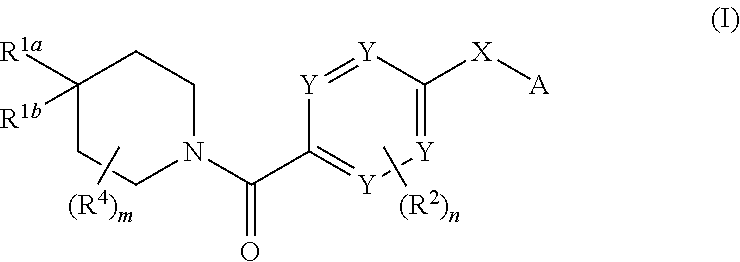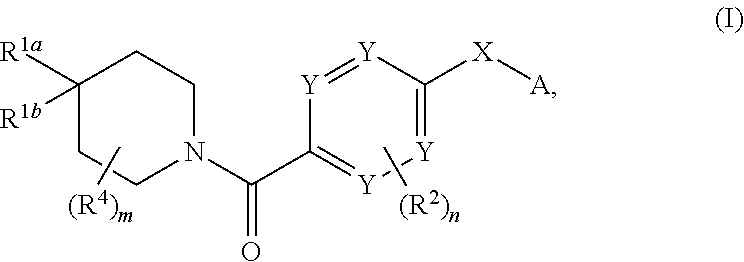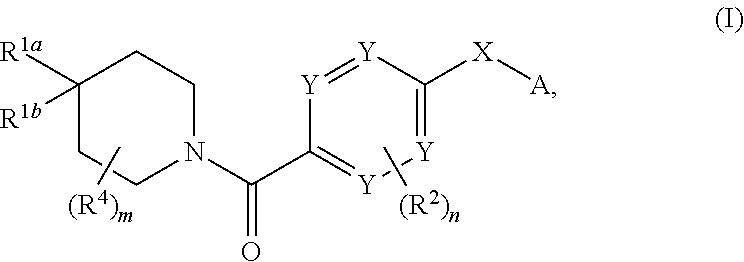Therapeutic compounds and compositions
a technology applied in the field of therapeutic compounds and compositions, can solve the problems of premature destruction and diminished lifetime of red blood cells (rbcs), inability to regenerate nadsup>+/sup, cell dehydration, contraction and crenation, etc., to increase the lifetime of rbcs, increase oxygen affinity, and increase the effect of red blood cell lifetim
- Summary
- Abstract
- Description
- Claims
- Application Information
AI Technical Summary
Benefits of technology
Problems solved by technology
Method used
Image
Examples
example 1
PKM2 Assay
Procedure:
[0255]PKM2 stock enzyme solution was diluted in Reaction Buffer[0256]2 μL of compound was added into each well first, and then 180 μL of the Reaction Mix was added.[0257]Reaction mixture with compound (without ADP) were incubated for 30 minutes at 4° C.[0258]Plates were re-equilibrated to room temperature prior to adding 20 μL ADP to initiate the reaction.[0259]Reaction progress was measured as changes in absorbance at 340 nm wavelength at room temperature (25° C.)
Reaction Mix: PKM2 (50 ng / well), ADP (0.7 mM), PEP (0.15 mM), NADH (180 μM), LDH (2 units) in Reaction Buffer
Reaction Buffer: 100 mM KCl, 50 mM Tris pH 7.5, 5 mM MgCl2, 1 mM DTT, 0.03% BSA.
example 2
Procedure:
[0260]PKR or PKR mutant enzyme solution was diluted in assay buffer.[0261]2 μL of test compound was added into wells first, and then 180 μL reaction mix was added.[0262]Reactions mixture with test compound was assembled except for ADP, and plates were stored for 60 minutes at room temperature.[0263]20 uL ADP was added to start reaction at room temperature and reaction progress was measured as changes in absorbance at 340 nm wavelength at room temperature.
[0264]Test Compound Preparation:[0265]Test compound stock was made at 100× concentration in 100% DMSO (10 mM)[0266]1 to 3 dilutions were made for 11 points (i.e. 50 μl of first concentration added to 100 μl 100% DMSO to yield 3.33 mM, 50 μl of this added to 100 μl DMSO to yield 1.11 mM, and so forth)[0267]1 to 100 dilution into assay (2 μl in 200 μl) yielded starting concentration of 100 μM, decreasing 3 fold for 11 points.
Assay Buffer: 100 mM KCl, 50 mM Tris 7.5, 5 mM MgCl2, 1 mM DTT, 0.03% BSA
[0268]Reacti...
example 3
PKR WT Single Point Percent Activation Assay
[0269]A compound described herein was diluted with DMSO and tested at 1 μM concentration. The enzyme was diluted in 1× Buffer: (100 mM KCl, 50 mM Tris 7.5, 5 mM MgCl2, 1 mM DTT, 0.03% BSA). 2 μL of compound solution was first added into wells, and then 180 μL of enzyme solution was added. Assays were assembled except for ADP, and plates were stored for 60 minutes at RT. 20 μL ADP was added to start the assay and assay output was evaluated using OD340 at SpectraMax. The assay was run at room temperature.
Final concentration: PKR wt (100 ng / well), Tris pH 7.5 (50 mM), KCl (100 mM), MgCl2 (5 mM), ADP (0.48 mM), PEP (0.15 mM), NADH (180 μM), LDH (0.5 units, Sigma 59023), DTT (1 mM) and BSA (0.03%).
PUM
| Property | Measurement | Unit |
|---|---|---|
| body weight | aaaaa | aaaaa |
| body weight | aaaaa | aaaaa |
| temperature | aaaaa | aaaaa |
Abstract
Description
Claims
Application Information
 Login to View More
Login to View More - R&D
- Intellectual Property
- Life Sciences
- Materials
- Tech Scout
- Unparalleled Data Quality
- Higher Quality Content
- 60% Fewer Hallucinations
Browse by: Latest US Patents, China's latest patents, Technical Efficacy Thesaurus, Application Domain, Technology Topic, Popular Technical Reports.
© 2025 PatSnap. All rights reserved.Legal|Privacy policy|Modern Slavery Act Transparency Statement|Sitemap|About US| Contact US: help@patsnap.com



